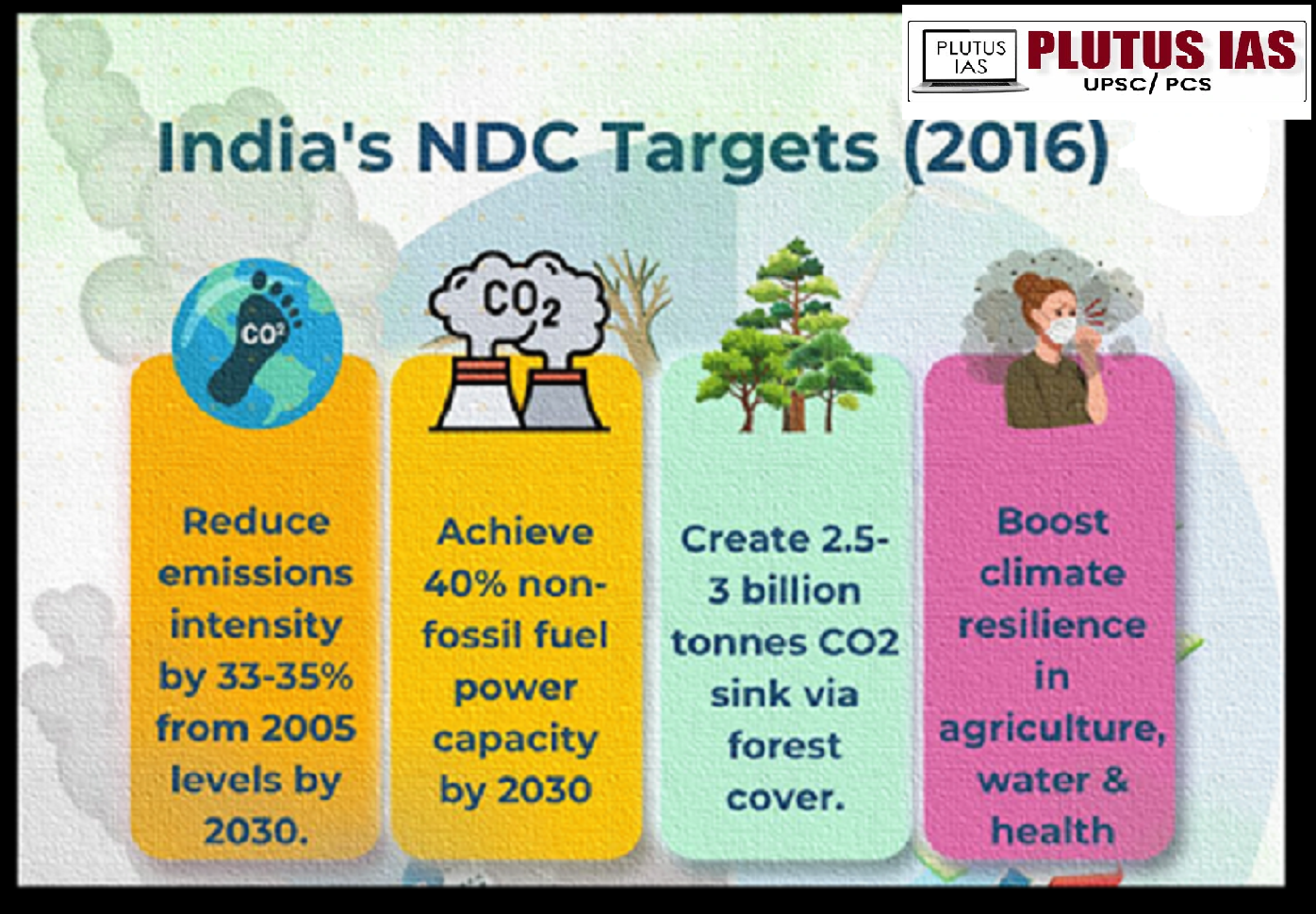16 Jan India’s Progress Towards Climate Resilience
SYLLABUS MAPPING:
GS-3-Environment- India’s Progress Towards Climate Resilience
FOR PRELIMS:
What is UNFCCC, Carbon Neutrality and India’s Panchmantras?
FOR MAINS
Key challenges and the way forward for India in its pursuit of climate resilience and carbon neutrality.
Why in the news?
India is the land of Mahatma Gandhi, whose vision for sustainable development inspires us greatly. We have shown what it is to realise key principles like Green Future and Net Zero.” ~ Prime Minister Shri Narendra Modi

India’s Climate Actions under UNFCCC:
1. NDC Targets:
Emissions Intensity:
Target: Reduce emissions intensity of GDP by 45% by 2030, compared to 2005 levels.
2. Non-Fossil Fuel Energy:
Target: Increase the share of non-fossil fuel-based energy in the total installed electric power capacity to 50% by 2030.
3. Net-Zero Emissions:
Target: Achieve net-zero emissions by 2070, marking a long-term goal in line with the global climate agenda.
4. Panchamrit Targets:
500 GW Non-Fossil Energy Capacity:
Target: Reach 500 GW of non-fossil fuel-based energy capacity by 2030.
50% Energy from Renewable Sources:
Target: Ensure that 50% of India’s energy needs come from renewable sources by 2030.

Key achievement in climate:
1. Historical GHG Emissions: India’s cumulative share of global GHG emissions (1850-2019) is 4%, despite having 17% of the world’s population.
2. Low Energy Consumption: In 2019, India’s annual primary energy consumption per capita was 28.7 GJ, much lower than both developed and developing countries.
3. Low-Carbon Pathways: India is committed to low-carbon development while ensuring energy access, security, and sustainable economic growth.
4. Climate Vulnerability: India’s diverse geography makes it highly vulnerable to climate change impacts like heatwaves, floods, and droughts.
5. Adaptation Strategies: Essential for safeguarding development, focusing on resilient infrastructure, water management, and sustainable agriculture.

Climate actions initiatives for carbon Neutrality:
1. Forest Land Diversion & Mitigation Measures
Forest Fragmentation Consideration: Forest fragmentation is addressed during forest land diversion approvals for non-forestry purposes under Van Adhiniyam, 1980.
Compensatory Afforestation: Mandatory afforestation for non-forestry land diversion, including soil and moisture conservation and eco-restoration.
“Ek Ped Maa Ke Naam” tree plantation Campaign: Nationwide tree plantation campaign launched on World Environment Day 2024.
Green Credit Program: Launched in 2023, the program focuses on tree plantation on identified degraded forest land parcels to generate green credits.
National Afforestation Programme (NAP): Pan-India afforestation in identified degraded forest areas with people’s participation and decentralized forest governance.
2. Urban Climate Adaptation & Low-Carbon Development
Mainstreaming Adaptation in Urban Planning: India’s LT-LEDS emphasizes integrating adaptation measures and enhancing energy and resource efficiency within urban planning policies and guidelines as key components of a low-carbon development pathway.
Sustainable Urban Planning Policies: The relevant policies and initiatives include Urban and Regional Development Plans Formulation and Implementation (URDPFI) guidelines, Town and Country Planning Act, Smart Cities Mission, Atal Mission for Rejuvenation and Urban Transformation (AMRUT), Pradhan Mantri Awaas Yojana (PMAY) and Swachh Bharat Mission (SBM).
3. Air Pollution Control & Clean Air Initiatives
National Clean Air Programme (NCAP): Aimed at improving air quality with city-specific action plans for 131 cities.
Funding & Implementation: Mobilized through various schemes such as SBM (Urban), AMRUT, Sustainable Alternative towards Affordable Transportation (SATAT), Faster Adoption and Manufacturing of Hybrid and Electric Vehicles (FAME-II)and Nagar Van Yojna.
Air Pollution Abatement Measures: Initiatives include cleaner fuels (CNG/LPG), ethanol blending, BS-VI fuel norms, and air quality management.
4. Coastal Ecosystem Conservation & Resilience
Mangrove & Coral Reef Conservation: Financial assistance provided to coastal states/UTs for enhancing climate resilience, including mangrove conservation.
Integrated Coastal Zone Management Plans (ICZMP) Plans for Coastal States: Prepared for Gujarat, Odisha, and West Bengal for coastal ecosystem protection.
Mangrove Initiative for Shoreline Habitats & Tangible Incomes (MISHTI) Program: Mangrove restoration/reforestation program launched in 2023, covering approximately 540 km² across 9 coastal states and 4 UTs.₹ 12.55 crores has been released to the states of Gujarat, West Bengal, Kerala and UT of Puducherry for the restoration of 3,046 ha. of mangroves in FY 2024-25.
5. Regulatory Measures for Climate Resilience: The Coastal Regulation Zone (CRZ) Notifications (2011 & 2019), issued under the Environment Protection Act, 1986, Wildlife Protection Act, 1972, Indian Forest Act, 1927, and Biological Diversity Act, 2002 for enhancing climate resilience.
Challenges:
1. High Dependence on Coal: India’s reliance on coal hampers emission reduction efforts; transitioning to cleaner energy requires significant investments and infrastructure changes.
2. Financial Constraints: Limited financial resources hinder large-scale renewable energy projects, climate adaptation, and advanced technologies like carbon capture and green hydrogen.
3. Energy Access and Security: Balancing energy access for rural populations with low-carbon transitions is challenging while ensuring energy security during the shift away from fossil fuels.
4. Vulnerability to Climate Impacts: India faces significant climate risks (heatwaves, floods, droughts), requiring strong adaptation measures, especially in vulnerable regions.
5. Infrastructure and Technology Gaps: The expansion of renewable energy requires modern grid infrastructure, energy storage, and overcoming integration challenges in renewable sources.
6. Urbanization and Pollution: Rapid urbanization strains air quality and waste management; sustainable urban planning and pollution control remain ongoing challenges.
7. Policy and Implementation Gaps: Inconsistent implementation of climate policies, particularly in rural and vulnerable areas, affects progress towards climate resilience.
8. Land Use and Deforestation: Urban sprawl and deforestation challenge land-use management; afforestation efforts are critical for enhancing resilience.
9. International Financing and Technology Transfer: India needs continued international financial and technological support to meet its climate targets, relying on commitments from developed nations.
Way forward:
1. Low Carbon Development of Electricity Systems: Low carbon development of electricity systems consistent with development
2. Integrated, Efficient, Inclusive, Low-Carbon Transport System: Develop an integrated, efficient, inclusive, low-carbon transport system
3. Promoting Adaptation in Urban Design & Sustainable Urbanization: Promoting adaptation in urban design, energy & material efficiency in buildings& sustainable urbanization
4. Economy-Wide Decoupling of Growth from Emissions: Promoting economy-wide decoupling of growth from emissions and development of an efficient, innovative, low-emission industrial system
5. CO2 Removal & Engineering Solutions: Investing in carbon dioxide removal (CDR) technologies and engineering solutions such as carbon capture and storage (CCS) to reduce atmospheric CO2 levels.
6. Enhancing Forest & Vegetation Cover: Enhancing Forest and Vegetation cover consistent with socio-economic and ecological considerations
7. Economic and Financial Aspects of Low-Carbon Development: Economic and financial aspects of low-carbon development and Long-Term Transition to net zero by 2070.
Conclusions:
India is advancing towards a carbon-neutral future with a focus on sustainable development and innovative solutions. Committed to reducing greenhouse gas emissions, India is implementing key initiatives like its Long-Term Low Emission Development Strategy and the Miyawaki tree planting at Mahakumbh 2025. These efforts ensure balanced growth and environmental responsibility, paving the way for a climate-resilient future.
Prelims Question:
Q. Consider the following statements about India’s climate actions:
1. India’s target is to achieve net-zero emissions by 2050.
2. India has committed to reducing emissions intensity of GDP by 45% by 2030.
3. The Panchamrit targets include reaching 500 GW of non-fossil fuel-based energy capacity by 2030.
Which of the above statements is correct?
A. 1 and 2 only
B. 2 and 3 only
C. 1 and 3 only
D. 2 only
Answer: B
Mains Question:
(250 words, 15 marks)



No Comments